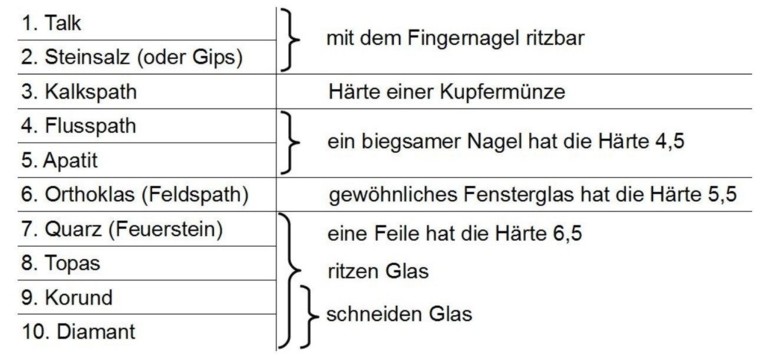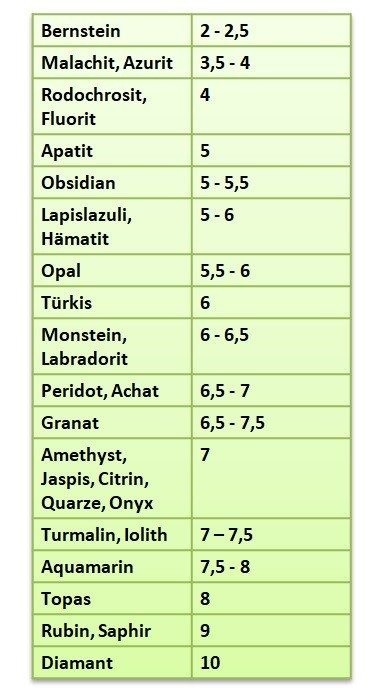If you want to take proper care of your jewelry, then sometimes it is like a little science in itself. Especially if your jewellery is set with precious stones, there are many little things to consider. One of these little things is for example the hardness of your gemstones. Because the hardness of your gemstones can decide which treatment your jewellery tolerates and above all: which not! :)
There are many known methods to determine the hardness of a gemstone. One of the best known scales used for this purpose is the so-called "Mohs' hardness scale". This is called so because it was originally developed by the German mineralogist Friedrich Mohs. This clever man wanted to determine the hardness of minerals in general and therefore introduced his Moh's hardness scale as early as 1822.
This scale is also called the "Ritz scale". Sounds a bit strange, but it is because the minerals are arranged in ascending order in the same way as the other minerals can be scratched or scored by them. Scribing in this case simply means scratching. So Mr. Mohs took some minerals and looked at which minerals scratch others and which minerals can be scratched by others.
 A simple example: He took a piece of talc and found that he could scratch it with his bare fingernail. So tallow was assigned a lower Mohs hardness than his fingernail. Then he tried to see if he could scratch window glass with his nail. This no longer worked, unlike talc. So window glass was again assigned a higher Mohs hardness than his fingernail. So he did this with countless minerals and arranged them according to the result on his Moh's scale from 1 to 10.
A simple example: He took a piece of talc and found that he could scratch it with his bare fingernail. So tallow was assigned a lower Mohs hardness than his fingernail. Then he tried to see if he could scratch window glass with his nail. This no longer worked, unlike talc. So window glass was again assigned a higher Mohs hardness than his fingernail. So he did this with countless minerals and arranged them according to the result on his Moh's scale from 1 to 10.
Among other things, he discovered that a diamond could scratch all other minerals, but could never be scratched itself. So the diamond got the Mohs hardness 10 and is therefore the hardest mineral we know.
What doesthis mean for your jewellery?

For gemstones to be used for jewellery, they must at least be hard enough to wear as little as possible when worn. Of course, soft and medium-hard gemstones and materials are also used for jewelry. Pearls are very soft with a Mohs hardness of 3 to 4.5 and gemstones such as turquoise or lapis lazuli are not very hard with a Mohs hardness of 5 to 6. All gemstones with a Mohs hardness below 7 should always be careful not to scratch them over time due to improper use.
Silver baths can also be harmful to gems with a soft to medium Mohs hardness (i.e. all gems with a Mohs hardness of up to 6.5). And even for gemstones that should actually be hard, caution is advised. For example, a ruby with a Mohs hardness of 9 is very hard, but in order to make a small ruby look bigger and more beautiful, rubies are often "filled up" with glass. This is called "glass-filled ruby". And glass with a Mohs hardness of 5.5 is not quite as hard and does not tolerate a silver bath at all. Thus, if you treated ruby in this way, you would also permanently damage the supposedly hard gemstone with a silver bath.
It is therefore not so easy to determine exactly what gemstones can and cannot tolerate. So if you are not quite sure, better go to a specialist(us! :)) and ask. That's better than realizing too late that something went wrong :)
However, the Mohs hardness is always a good reference point to determine whether your gemstone is rather fragile or a bit more robust. Basically you can hold on to it: The lower the Mohs hardness, the more sensitive your gemstone will tend to be. The higher the Mohs hardness, the more stable your gemstone tends to be and the more it will probably endure. Provided, of course, that your gemstone has not been treated in any other way that affects its Mohs hardness.
Gold and silver are relatively soft with a Mohs hardness of 2.5, but these metals do not mind a bath in silver or gold bath!
And of course you can also see from this table here what you actually wanted to know when you opened this page: The hardness of the different gemstones ;)
There are many known methods to determine the hardness of a gemstone. One of the best known scales used for this purpose is the so-called "Mohs' hardness scale". This is called so because it was originally developed by the German mineralogist Friedrich Mohs. This clever man wanted to determine the hardness of minerals in general and therefore introduced his Moh's hardness scale as early as 1822.
This scale is also called the "Ritz scale". Sounds a bit strange, but it is because the minerals are arranged in ascending order in the same way as the other minerals can be scratched or scored by them. Scribing in this case simply means scratching. So Mr. Mohs took some minerals and looked at which minerals scratch others and which minerals can be scratched by others.
 A simple example: He took a piece of talc and found that he could scratch it with his bare fingernail. So tallow was assigned a lower Mohs hardness than his fingernail. Then he tried to see if he could scratch window glass with his nail. This no longer worked, unlike talc. So window glass was again assigned a higher Mohs hardness than his fingernail. So he did this with countless minerals and arranged them according to the result on his Moh's scale from 1 to 10.
A simple example: He took a piece of talc and found that he could scratch it with his bare fingernail. So tallow was assigned a lower Mohs hardness than his fingernail. Then he tried to see if he could scratch window glass with his nail. This no longer worked, unlike talc. So window glass was again assigned a higher Mohs hardness than his fingernail. So he did this with countless minerals and arranged them according to the result on his Moh's scale from 1 to 10.Among other things, he discovered that a diamond could scratch all other minerals, but could never be scratched itself. So the diamond got the Mohs hardness 10 and is therefore the hardest mineral we know.
What doesthis mean for your jewellery?

For gemstones to be used for jewellery, they must at least be hard enough to wear as little as possible when worn. Of course, soft and medium-hard gemstones and materials are also used for jewelry. Pearls are very soft with a Mohs hardness of 3 to 4.5 and gemstones such as turquoise or lapis lazuli are not very hard with a Mohs hardness of 5 to 6. All gemstones with a Mohs hardness below 7 should always be careful not to scratch them over time due to improper use.
Silver baths can also be harmful to gems with a soft to medium Mohs hardness (i.e. all gems with a Mohs hardness of up to 6.5). And even for gemstones that should actually be hard, caution is advised. For example, a ruby with a Mohs hardness of 9 is very hard, but in order to make a small ruby look bigger and more beautiful, rubies are often "filled up" with glass. This is called "glass-filled ruby". And glass with a Mohs hardness of 5.5 is not quite as hard and does not tolerate a silver bath at all. Thus, if you treated ruby in this way, you would also permanently damage the supposedly hard gemstone with a silver bath.
It is therefore not so easy to determine exactly what gemstones can and cannot tolerate. So if you are not quite sure, better go to a specialist(us! :)) and ask. That's better than realizing too late that something went wrong :)
However, the Mohs hardness is always a good reference point to determine whether your gemstone is rather fragile or a bit more robust. Basically you can hold on to it: The lower the Mohs hardness, the more sensitive your gemstone will tend to be. The higher the Mohs hardness, the more stable your gemstone tends to be and the more it will probably endure. Provided, of course, that your gemstone has not been treated in any other way that affects its Mohs hardness.
Gold and silver are relatively soft with a Mohs hardness of 2.5, but these metals do not mind a bath in silver or gold bath!
And of course you can also see from this table here what you actually wanted to know when you opened this page: The hardness of the different gemstones ;)